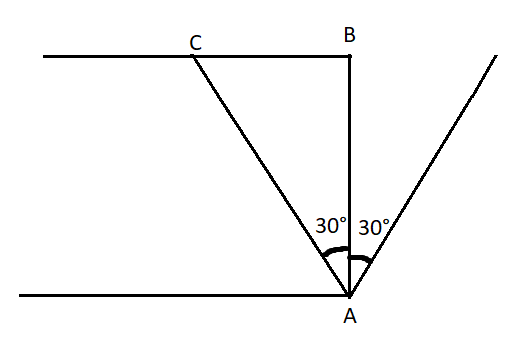
Two parallel plane mirrors ${M_1}$and ${M_2}$ have a length of $2m$ each and are $20mm$ apart. A ray of light is incident on one end of the mirror ${M_2}$ at an angle ${30^ \circ }$. The number of reflection, the light ray undergoes before it reaches the other one would be

$\Delta ABC\tan {30^ \circ } = \dfrac{{BC}}{{AB}}$
$BC = 20mm\tan {30^ \circ }$
$l = N \times BC$
(A) $173$
(B) $84$
(C) $346$
(D) $42$
Answer
218.1k+ views
HintThe reflection of the mirror causes the deviation of the incident ray. Here we have two mirrors kept in parallel. For the incident ray falling at one end of one of the parallel mirrors will be deviated due to the reflection of the mirror. This will continue until it reaches the other end.
Step by step solution
The angle of incidence is given as ${30^ \circ }$
The separation between the mirrors is given as $20mm = 2cm$
By applying trigonometry,
The distance travelled by the ray to deviate from the normal in each reflection to reach the other end can be written as: $BC = 2 \times \tan {30^ \circ } = 1.1547cm$
Let us assume that the number of reflections is $N$
The total deviation that the incident ray underwent from the point of incidence can be written as: $1.1547N$
The length of the mirror is given by $2m = 200cm$
The length of the mirror is $l = N \times BC$
From this, we can write the number of reflections as,
$N = \dfrac{l}{{BC}}$
Substituting the values we get
$N = \dfrac{{200}}{{1.1547}} = 173.310$
The answer is Option (A): $173$
Note
As $0.310 \times 1.1547 = 0.3577 < 1.1547$ so it cannot be taken as one full reflection hence we can neglect the decimal part. The angle between the ray of incidence and the normal is called the angle of incidence. The angle between the ray of reflection and the normal is called the angle of reflection. The images produced by real objects in the plane mirrors are always virtual and the images produced by virtual objects are always real. Plane mirrors have an infinite focal length. The optical power of a plane will be zero. In plane mirrors the images will be laterally inverted.
Step by step solution
The angle of incidence is given as ${30^ \circ }$
The separation between the mirrors is given as $20mm = 2cm$
By applying trigonometry,
The distance travelled by the ray to deviate from the normal in each reflection to reach the other end can be written as: $BC = 2 \times \tan {30^ \circ } = 1.1547cm$
Let us assume that the number of reflections is $N$
The total deviation that the incident ray underwent from the point of incidence can be written as: $1.1547N$
The length of the mirror is given by $2m = 200cm$
The length of the mirror is $l = N \times BC$
From this, we can write the number of reflections as,
$N = \dfrac{l}{{BC}}$
Substituting the values we get
$N = \dfrac{{200}}{{1.1547}} = 173.310$
The answer is Option (A): $173$
Note
As $0.310 \times 1.1547 = 0.3577 < 1.1547$ so it cannot be taken as one full reflection hence we can neglect the decimal part. The angle between the ray of incidence and the normal is called the angle of incidence. The angle between the ray of reflection and the normal is called the angle of reflection. The images produced by real objects in the plane mirrors are always virtual and the images produced by virtual objects are always real. Plane mirrors have an infinite focal length. The optical power of a plane will be zero. In plane mirrors the images will be laterally inverted.
Recently Updated Pages
Young’s Double Slit Experiment Derivation Explained

Wheatstone Bridge Explained: Working, Formula & Uses

Chemical Properties of Hydrogen - Important Concepts for JEE Exam Preparation

JEE General Topics in Chemistry Important Concepts and Tips

JEE Atomic Structure and Chemical Bonding important Concepts and Tips

JEE Amino Acids and Peptides Important Concepts and Tips for Exam Preparation

Trending doubts
JEE Main 2026: Application Form Open, Exam Dates, Syllabus, Eligibility & Question Papers

Derivation of Equation of Trajectory Explained for Students

Hybridisation in Chemistry – Concept, Types & Applications

Understanding the Angle of Deviation in a Prism

Understanding Collisions: Types and Examples for Students

Understanding Atomic Structure for Beginners

Other Pages
JEE Advanced Marks vs Ranks 2025: Understanding Category-wise Qualifying Marks and Previous Year Cut-offs

How to Convert a Galvanometer into an Ammeter or Voltmeter

Understanding Centrifugal Force in Physics

Ideal and Non-Ideal Solutions Explained for Class 12 Chemistry

Degree of Dissociation: Meaning, Formula, Calculation & Uses

Understanding Electromagnetic Waves and Their Importance




